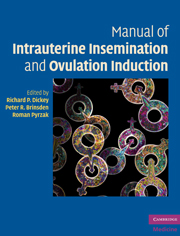Book contents
- Frontmatter
- Contents
- List of contributors
- Preface
- 1 An overview of intrauterine insemination and ovulation induction
- 2 Male causes of infertility: evaluation and treatment
- 3 Female causes of infertility: evaluation and treatment
- 4 Clinic and laboratory design, personnel and equipment
- 5 Semen analysis: semen requirements for intrauterine insemination
- 6 Semen preparation for intrauterine insemination
- 7 Ovulation induction for intrauterine insemination I: oral drugs clomiphene, tamoxifen, letrozole
- 8 Ovulation induction for intrauterine insemination II: gonadotropins and oral drug–gonadotropin combinations
- 9 Ultrasonography in the management of ovulation induction and intrauterine insemination
- 10 Insemination technique and insemination complications
- 11 Cryopreservation
- 12 Donor sperm
- 13 The role of the nurse in intrauterine insemination and ovulation induction
- 14 Complications of ovulation induction I: high-order multiple births, miscarriage, ectopic pregnancy, congenital anomalies, ovarian cancer
- 15 Complications of ovulation induction II: ovarian hyperstimulation syndrome, ovarian torsion
- 16 The psychological issues of intrauterine insemination
- 17 Ethical, legal and religious considerations of artificial insemination
- Index
6 - Semen preparation for intrauterine insemination
Published online by Cambridge University Press: 01 February 2010
- Frontmatter
- Contents
- List of contributors
- Preface
- 1 An overview of intrauterine insemination and ovulation induction
- 2 Male causes of infertility: evaluation and treatment
- 3 Female causes of infertility: evaluation and treatment
- 4 Clinic and laboratory design, personnel and equipment
- 5 Semen analysis: semen requirements for intrauterine insemination
- 6 Semen preparation for intrauterine insemination
- 7 Ovulation induction for intrauterine insemination I: oral drugs clomiphene, tamoxifen, letrozole
- 8 Ovulation induction for intrauterine insemination II: gonadotropins and oral drug–gonadotropin combinations
- 9 Ultrasonography in the management of ovulation induction and intrauterine insemination
- 10 Insemination technique and insemination complications
- 11 Cryopreservation
- 12 Donor sperm
- 13 The role of the nurse in intrauterine insemination and ovulation induction
- 14 Complications of ovulation induction I: high-order multiple births, miscarriage, ectopic pregnancy, congenital anomalies, ovarian cancer
- 15 Complications of ovulation induction II: ovarian hyperstimulation syndrome, ovarian torsion
- 16 The psychological issues of intrauterine insemination
- 17 Ethical, legal and religious considerations of artificial insemination
- Index
Summary
Introduction
The objective of sperm preparation for intrauterine insemination (IUI) is to separate seminal fluid containing prostaglandins from sperm by centrifugation so that the latter can be introduced into the uterus without causing severe cramping. If semen is mixed with a buffered solution supplemented with human serum albumin (HSA) before centrifuging, constituents that stabilize the sperm membrane and prevent capacitation are removed. Advanced preparation procedures described in this chapter select out motile and superior-quality sperm by removing dead and abnormal sperm, immature sperm cells, white cells and debris – thus mimicking the in-vivo process of selecting motile sperm as they progress through the female reproductive tract, while leaving behind dead and immotile sperm and debris. Dead, immotile and abnormal sperm produce 10–15 times more reactive oxygen species (ROS) than motile sperm. High levels of ROS reduce fertilization potential.
Many methods have been described in the past for preparation of sperm for IUI. The three principal methods in use today are:
Standard sperm wash (SSW) – which removes seminal plasma from the semen specimen by centrifugation.
Swim-up (SWU) – which uses self-migration of motile sperm from the bottom fraction to the top fraction, followed by centrifugation to remove dead and immotile sperm and debris.
Density gradient centrifugation (DGC) – which separates motile sperm by density, using repeated centrifugation of semen mixed with a media containing a colloidal suspension of silica products. Motile sperm have higher density than non-motile and dead sperm.
- Type
- Chapter
- Information
- Publisher: Cambridge University PressPrint publication year: 2009
- 1
- Cited by

